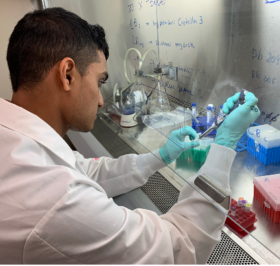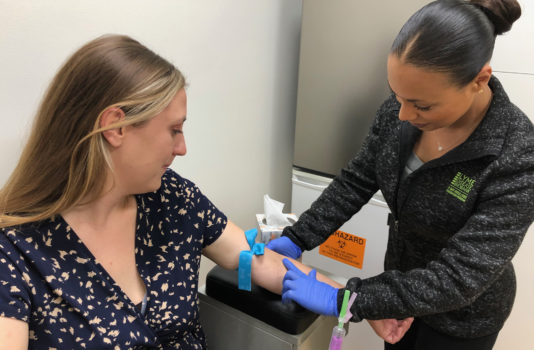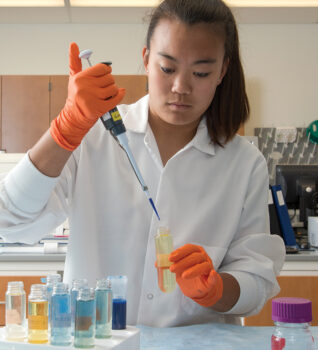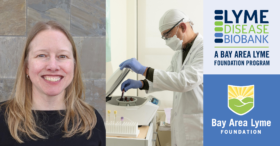BAL Spotlight Series
In this interview, the LymeX Diagnostic Prize talked with Liz Horn, PhD/MDI, Principal Investigator for Bay Area Lyme Foundation’s Lyme Disease Biobank (LDB), about her work in Lyme disease, the challenges researchers face, how the LymeX Diagnostics Prize could help further our understanding of the disease and how Lyme patient samples from our biobank are critical to the competition’s success.
This interview has been edited from the original.
“What’s exciting about the LymeX Diagnostics Prize is that you have a lot of different people with good ideas and different teams with a lot of different technologies trying to solve this problem.”
– Liz Horn, PhD/MDI
 The LymeX Diagnostics Prize is a multiphase competition funded by the US Department of Health and Human Services (HHS) and the Steven & Alexandra Cohen Foundation to accelerate the development of Lyme disease diagnostics. Through October 2023, the 10 teams selected to be part of Phase 2 of the LymeX Diagnostics Prize are participating in a virtual accelerator designed to help them refine their concepts for detecting active Lyme disease infections in people. As the Phase 2 accelerator cohort continues to develop their diagnostics, the teams have access to scientific advisors who provide valuable insight and feedback from their extensive experience in Lyme disease diagnostics, one of whom is Dr. Horn. The Phase 2 cohort also has access to the blood and urine samples donated to LDB by Lyme patients.
The LymeX Diagnostics Prize is a multiphase competition funded by the US Department of Health and Human Services (HHS) and the Steven & Alexandra Cohen Foundation to accelerate the development of Lyme disease diagnostics. Through October 2023, the 10 teams selected to be part of Phase 2 of the LymeX Diagnostics Prize are participating in a virtual accelerator designed to help them refine their concepts for detecting active Lyme disease infections in people. As the Phase 2 accelerator cohort continues to develop their diagnostics, the teams have access to scientific advisors who provide valuable insight and feedback from their extensive experience in Lyme disease diagnostics, one of whom is Dr. Horn. The Phase 2 cohort also has access to the blood and urine samples donated to LDB by Lyme patients.
A cancer biologist by training, Dr. Horn has spent her career working with nonprofit research organizations to help build research programs, registries, and biorepositories. She joined Bay Area Lyme Foundation in 2013 to lead the creation of a Lyme disease biorepository. As a scientific advisor for the LymeX Diagnostics Prize, Dr. Horn is mentoring participating teams through office hours and webinars.
LymeX: As the principal investigator for the Bay Area Lyme Foundation’s Lyme Disease Biobank, you have extensive experience in Lyme disease research. How did you first start working in the field, and what are you focusing on now with the biorepository?
Dr. Horn: When I was a graduate student, I needed fresh tumor samples. So I had to build a biorepository in our lab that then went on to be this bigger initiative that lasted for over 20 years—it was really quite cool. But that gave me the background to then start doing this for nonprofits. I’ve worked with autoimmune diseases, inflammatory diseases, and rare diseases.
Working with the Bay Area Lyme Foundation was my first venture into infectious disease, and Lyme disease is different from a lot of the other disease areas I’ve worked in. We set up the biorepository as a pilot study in 2014. We expanded to two sites in 2015, and we’ve been able to grow it to more than 1,200 participants. We collect blood and urine samples from people with early and persistent Lyme disease and endemic controls, and we’ve also started a tissue bank.
For our early Lyme cohort, we enroll participants based on signs and symptoms of Lyme disease—it’s a clinical diagnosis. At the end of the season, we test all the samples—we even test the controls. We look for tick-borne pathogens (Borrelia, Babesia, Anaplasma, and Ehrlichia) by PCR and perform standard two-tiered Lyme serology. While serology can be insensitive in early disease, we have serology data on all samples and even the controls. Something that’s going to be challenging, both for the prize and for any novel diagnostic being developed, is that the current standard is two-tiered serology. So if you have a test that’s novel, detects active infection, or directly detects the pathogen, what can you compare it to? In these cases, it doesn’t make sense to compare it to two-tiered serology, which is an indirect test. That’s where guidance from the FDA can help us start to think about how we confirm that these early cases are Lyme cases. It’s definitely a challenge for how we characterize our samples.
We have many research groups using biobank samples, and we require investigators to give the data back to us. When we discover new information about certain samples from different experiments, that data becomes part of the biobank, and there’s an opportunity to share with additional researchers. For example, there was one researcher who had a really novel direct detection method, and he found some rickettsiae pathogens in our samples. We don’t test for rickettsiae pathogens. It’s only a few samples, but we can now share these findings with other research teams as needed.
LymeX: Lyme disease is a particularly complex infectious disease. Having worked with extensive studies on the disease, what do you see as some of the biggest challenges for researchers?
Dr. Horn: The bacteria doesn’t behave the way other bacteria behave, and that makes it challenging. And also, it’s just very hard to find in people. Normally, you find bacteria, you culture it, it grows out, you know what it is; it’s really hard to do that in Lyme disease. The bacteria itself goes into the tissue, which, again, makes it hard to do blood tests for diagnostics.
There aren’t enough well-characterized samples for all the research that is being done. Collecting early Lyme samples can be very challenging. So if you were working on a cancer clinical trial, people would be going to academic medical centers and you would enroll them there. Academic medical centers are used to doing research; they have whole research departments. In Lyme disease, you have to collect samples where people are presenting with signs and symptoms of early Lyme. Often that’s in family practice, it could be at urgent care, it could be in the ER, and it’s not typically at your traditional academic medical center. It’s not that you can’t collect there, but Lyme forces you to collect samples in non-traditional spaces and with people whose primary focus is not on research.
 We also need samples collected from multiple endemic areas. We know with climate change that the ticks are moving; we know that Lyme disease is spreading across the country. That’s been known for more than 20 years. An ecologist once told me once that there are places in California as big as Connecticut where Lyme disease is as endemic as it is in Connecticut. But trying to create awareness of what’s actually happening in the West and setting up collection sites is challenging. There are a lot of people who have grown up in endemic areas and have moved to other regions. The other challenging part is that people travel. In places where there’s not a lot of Lyme disease, that makes it very hard for diagnosis—because it’s just not on practitioners’ radars.
We also need samples collected from multiple endemic areas. We know with climate change that the ticks are moving; we know that Lyme disease is spreading across the country. That’s been known for more than 20 years. An ecologist once told me once that there are places in California as big as Connecticut where Lyme disease is as endemic as it is in Connecticut. But trying to create awareness of what’s actually happening in the West and setting up collection sites is challenging. There are a lot of people who have grown up in endemic areas and have moved to other regions. The other challenging part is that people travel. In places where there’s not a lot of Lyme disease, that makes it very hard for diagnosis—because it’s just not on practitioners’ radars.
LymeX: What do you see as some of the biggest challenges for patients and providers?
Dr. Horn: Our diagnostics for early Lyme disease are just not cutting it. We need accurate diagnostics for early disease. The challenge is that our current diagnostics are serology-based, so you need the time for the immune system to mount a response. If you’re a patient coming in during that very early window, you probably won’t have antibodies forming. The provider will have to diagnose you based on signs and symptoms, because your serology tests will be negative, and our current testing can’t help support a diagnosis.
We published a study on the first 550 samples in our early Lyme disease cohort and controls. Of those presenting with a physician-diagnosed erythema migrans (an expanding rash that can be an early sign of Lyme disease) greater than five centimeters, only 29% tested positive by two-tiered serology. And that’s with a physician diagnosis in places where physicians see a lot of early Lyme disease and know what they’re looking for. We also know that a subset of people who get treated with antibiotics don’t get better; we also need better diagnostics for people with persistent disease.
“Our diagnostics for early Lyme disease are just not cutting it. We need accurate diagnostics for early disease. We also know that a subset of people who get treated with antibiotics don’t get better; we also need better diagnostics for people with persistent disease.”
 It’s also really important for the public to know all Lyme rashes (erythema migrans) are not all bullseye rashes. Every time you search online and see a picture of Lyme disease, you see a bullseye, but they don’t all look like that. Many Lyme rashes are reddish pink across the entire rash, don’t have central clearing, and don’t look like a target. It’s a huge challenge when someone takes a picture of a rash and they show it to a clinician and they may say, “Oh, it’s not a bullseye. It’s not Lyme disease.” The CDC and Lyme advocacy groups have done a lot of education around the fact that not all Lyme rashes are bullseyes. We also just published a paper looking at different presentations of Lyme rashes in biobank participants from Wisconsin.
It’s also really important for the public to know all Lyme rashes (erythema migrans) are not all bullseye rashes. Every time you search online and see a picture of Lyme disease, you see a bullseye, but they don’t all look like that. Many Lyme rashes are reddish pink across the entire rash, don’t have central clearing, and don’t look like a target. It’s a huge challenge when someone takes a picture of a rash and they show it to a clinician and they may say, “Oh, it’s not a bullseye. It’s not Lyme disease.” The CDC and Lyme advocacy groups have done a lot of education around the fact that not all Lyme rashes are bullseyes. We also just published a paper looking at different presentations of Lyme rashes in biobank participants from Wisconsin.
LymeX: The LymeX Diagnostics Prize utilizes open innovation to accelerate research. Through this model, the teams receive cash prizes alongside access to a range of non-monetary resources. What’s made you most excited to be a part of the prize competition?
Dr. Horn: What’s exciting about the LymeX Diagnostics Prize is that you have a lot of different people with good ideas and different teams with a lot of different technologies trying to solve this problem. The timing for the LymeX Diagnostics Prize is also really good, because if this happened five to seven years ago, the resources in the community wouldn’t have been there, and there just wouldn’t have been the samples to do the work. Our biobank is almost 10 years old. It takes a long time to collect samples, and multiple years of collection.
“The timing for the LymeX Diagnostics Prize is also really good, because if this happened five to seven years ago, the resources in the community wouldn’t have been there, and there just wouldn’t have been the samples to do the work. Our biobank is almost 10 years old. It takes a long time to collect samples, and multiple years of collection.”
Grants can really help build the body of knowledge, the scientific evidence and foundation. With the LymeX Diagnostics Prize, you have the opportunity to do things that a grant wouldn’t fund—that are more innovative, that could be higher-risk. You have the opportunity to take a chance on something, and if you have a good idea, you can really run with it. What was really neat about this competition is that in Phase 1, you didn’t need preliminary data. You can’t get a grant with just a good idea; you need preliminary data.
We’re woefully underfunded in Lyme disease, so all of these things—grants from government agencies, prize competitions, and funding from nonprofit organizations—are complementary. As the teams advance through the competition, hopefully they will be able to use what they’re doing with their data to get additional funding to really expand their work even beyond the LymeX Diagnostics Prize.
The teams also have a unique opportunity to collaborate together, not just on diagnostics, but also in understanding the science. Many of them are approaching this from a different scientific mechanism and perspective. This disease is very complicated, and we don’t fully understand what’s going on from a pathogenesis standpoint, especially for people who have persistent Lyme disease. What is causing persistent Lyme? Is it the bacteria? Is it an autoimmune response? Is it something else? Is it a combination of all of these?
Science can be very siloed and fragmented, and everyone’s working in their own little corner. We need more opportunities for scientists to interact, to discuss new ideas, to really work together and build collaborations. One of the things that’s been a little bit challenging in these past few years, especially with the pandemic, is the lack of scientific meetings and fewer opportunities to collaborate. They’re still not completely back, and not having as many forums to meet people, to talk about new ideas, and to build these collaborations is tough. I hope some of these teams will work together—if not on the diagnostic, possibly on some other projects that they’re working on.
“Science can be very siloed and fragmented, and everyone’s working in their own little corner. We need more opportunities for scientists to interact, to discuss new ideas, to really work together and build collaborations.”

LymeX: As you’ve noted, the teams are approaching the challenge of Lyme disease diagnostics in very unique ways. How could their approaches and research benefit the field beyond testing?
Dr. Horn: One of the challenges we have is we know so much about the challenges with Lyme disease, because it affects so many people and it’s the most common tick-borne infection. But there are a lot of other tick-borne diseases that are also important, can have very bad health outcomes, and are very hard to detect. With some of these technologies, there might be ways to apply them to other tick-borne infections.
As Phase 2 of the diagnostics prize comes to a close this fall, participants have refined the detailed concepts and development plans they originally submitted in Phase 1. By advancing the scientific and technical maturity of their proposed solutions, they are accelerating progress toward anticipated regulatory submission. In December 2023, up to 5 Phase 2 winners will receive at least $250,000 from the $2 million Phase 2 prize pool, and additional phases will be announced. We eagerly await the outcomes of the LymeX prize and wish all of the teams involved the very best of luck!
About the LymeX Diagnostics Prize
The LymeX Diagnostics Prize is a multiphase competition to accelerate the development of Lyme disease diagnostics. The $1 million Phase 1 called on scientific, technical, and clinical experts to submit innovative methods for detecting active Lyme disease infections in people.
In January 2023, the U.S. Department of Health and Human Services (HHS) and the Steven & Alexandra Cohen Foundation launched the $2 million Phase 2 inviting the 10 Phase 1 winners to participate in a virtual accelerator. The accelerator offers the cohort access to virtual learning, mentorship, biorepository subject matter expertise, and networking opportunities designed to help the teams progress toward FDA review. The ultimate goal of the multiphase competition is to nurture the development of these diagnostics toward Food and Drug Administration review. Thanks to a $10 million pledge to the LymeX Diagnostics Prize from the Steven & Alexandra Cohen Foundation, $7 million in additional LymeX prizes are projected to be available in proposed future phases.
This blog is part of our BAL Spotlights Series. It is based on an interview first published in August 2023 by the LymeX Diagnostic Prize and is reproduced here with permission. Bay Area Lyme Foundation provides reliable, fact-based information so that prevention and the importance of early treatment are common knowledge. For more information about Bay Area Lyme, including our research and prevention programs, go to www.bayarealyme.org.

please use BOLD when you use a light color like blue above … here’s an example of the text and SHORTER paragraphs please for us neuro cognitive LD/adhd patients who have lost our reading comprehension.
thanks for understanding 😉
“The timing for the LymeX Diagnostics Prize is also really good, because if this happened five to seven years ago, the resources in the community wouldn’t have been there, and there just wouldn’t have been the samples to do the work.
Our biobank is almost 10 years old. It takes a long time to collect samples, and multiple years of collection.”